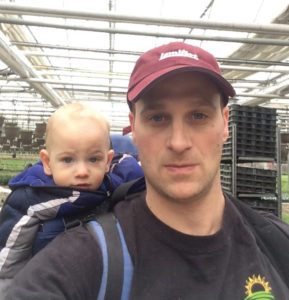Peak Season Challenges
The 2017 spring season rush has slowed, and now is the time to review what went wrong, what went right and what we can improve for 2018. While the final numbers are not in yet, we have a pretty good picture of the results of this shipping season. With all of the problems that a typical spring shipping rush hits growers with, this season in particular highlighted a few and focused our attention on one in particular: Labor.
For years we have worked to diversify our product offering in all seasons. We built different types of structures to accommodate different crops with hoops, glass and outdoor production space and poured concrete to make sure shipping carts can get to as many places in the greenhouse as possible. We have created order picking and shipping efficiencies and computerized our order system.
All of these efforts seem meager when the peak of the shipping season hits and I have run out of skilled hands to hit our peak sales window. It is those hands that have to get our product from the greenhouse onto a cart and into a truck — and the truck down the road.
Labor Considerations

In most years, quality and affordability were my focus when looking for labor, and when measuring this season, quality of labor may be paramount to affordability. Just getting people to show up is not always the best solution as low productivity can be a very expensive proposition when orders are not filled or filled incorrectly.
Labor is in short supply in New Jersey again this year, and good labor is in very short supply. Training new people every other day was a problem for us this year, and this is very wasteful and expensive. Explaining to people that you can’t stack two flats of geraniums on top of each other may seem obvious to us, but not to temporary labor. When the labor crews would show up each morning, we could only hope that more people had worked the day or days before. But unfortunately new arrivals made the first part of my day nothing but a quick training tutorial.
Many growers that I speak to report the same problems and politics may play a role in this, but as a business owner I don’t have the luxury of opining on political opinions. I only know that governmental policies are something I will always have to navigate. H-2A does not seem like a good solution for a grower my size both in expense and bureaucracy. To further the politics surrounding labor, a bill is currently waiting a new governor in New Jersey that would have the effect of just about doubling the minimum wage. Word on the street is this bill has a very high probability of passing. Again I can’t afford to wax political, I simply have to navigate the minefield of running a business. And labor is one of the biggest obstacles we have to manage right now.
Automating a Solution
Of course automation is solving some of the problems, especially at peak planting. We have invested in sticking, sowing and transplanting, and have become very good at filling our space up efficiently. With our current automation in transplanting we can transplant any size plug into any container with a speed that only a machine can perform. It was only a few years back that all of our transplanting was done by hand, and it took a lot of labor. Automation has solved this problem for the peak production season.
With a strong production and growing team we have been able to improve our efficiency and quality, but without good seasonal labor how can we get it shipped in a timely manner?
I have seen some of the automation that the European growers have implemented and where it seems best served in terms of shipping finished product is in monoculture growers. We have taken the time to develop as broad of a product offering as possible for our business to maximize sales. This has led to an increase in types of containers we grow in and puts further pressure on the shipping season. Teaching labor that an 11-inch deck planter is very different than a 12-inch hanging basket combo seems simple enough while I write this, but it is a major problem during peak shipping. This approach has left us with few options to automate getting the product off the floor and into the truck. Right now I would call this our permanent problem. We used to be in search of “shoulder business” or sales not at the peak window of the season, but the demand for peak season sales remains very strong and while non-peak business is helpful to our cash flow, we are left with seasonal labor as a problem that needs a solution.
The news media has been suggesting that someday soon we can expect driverless trucking. Can we automate picking, packing and loading? Or will we be forced to because labor shortages and costs may be the mother of invention?


 Video Library
Video Library 




















